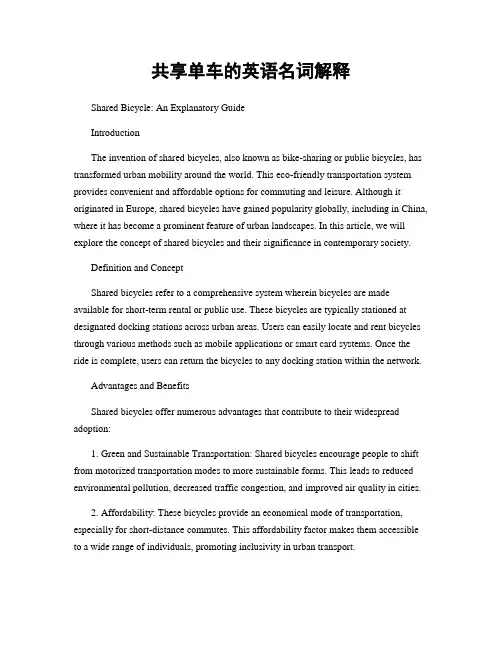共享单车英语[优质ppt]
- 格式:ppt
- 大小:1.80 MB
- 文档页数:10


共享单车的英语名词解释Shared Bicycle: An Explanatory GuideIntroductionThe invention of shared bicycles, also known as bike-sharing or public bicycles, has transformed urban mobility around the world. This eco-friendly transportation system provides convenient and affordable options for commuting and leisure. Although it originated in Europe, shared bicycles have gained popularity globally, including in China, where it has become a prominent feature of urban landscapes. In this article, we will explore the concept of shared bicycles and their significance in contemporary society.Definition and ConceptShared bicycles refer to a comprehensive system wherein bicycles are made available for short-term rental or public use. These bicycles are typically stationed at designated docking stations across urban areas. Users can easily locate and rent bicycles through various methods such as mobile applications or smart card systems. Once the ride is complete, users can return the bicycles to any docking station within the network.Advantages and BenefitsShared bicycles offer numerous advantages that contribute to their widespread adoption:1. Green and Sustainable Transportation: Shared bicycles encourage people to shift from motorized transportation modes to more sustainable forms. This leads to reduced environmental pollution, decreased traffic congestion, and improved air quality in cities.2. Affordability: These bicycles provide an economical mode of transportation, especially for short-distance commutes. This affordability factor makes them accessible to a wide range of individuals, promoting inclusivity in urban transport.3. Health and Fitness: The utilization of shared bicycles encourages physical activity and promotes a healthier lifestyle. Regular cycling improves cardiovascular fitness, enhances muscle strength, and aids weight management.4. Last-Mile Connectivity: Shared bicycles effectively bridge the gap between public transit stations and final destinations. This last-mile connectivity makes commuting more convenient and time-efficient, reducing reliance on taxis or other expensive modes of transport.Challenges and SolutionsAlthough shared bicycles have revolutionized urban transport, they also face certain challenges that need to be addressed:1. Parking and Docking Issues: Improperly parked or abandoned bicycles can impede traffic flow, cause clutter, and inconvenience pedestrians. Authorities must enforce stricter regulations and incentivize responsible parking behavior to mitigate these issues.2. Maintenance and Safety: Regular maintenance and upkeep of the bicycles are essential to ensure users' safety and the longevity of the fleet. Bicycle-sharing companies should prioritize these aspects by implementing robust maintenance and inspection protocols.3. Theft and Vandalism: Shared bicycles are susceptible to theft and vandalism. Companies can tackle this risk by incorporating advanced tracking technologies, encouraging user responsibility, and collaborating with local law enforcement agencies.4. Infrastructure Adaptation: To accommodate shared bicycles, cities need to invest in infrastructure, including dedicated bicycle lanes, parking stations, and spaces for maintenance and redistribution of the fleet. Cooperation between local authorities and bike-sharing companies is crucial to develop a comprehensive and sustainable urban cycling network.ConclusionShared bicycles have redefined urban transportation by offering a convenient and sustainable alternative. Their benefits encompass environmental, economic, and health aspects while improving connectivity and reducing reliance on motorized vehicles. However, addressing challenges related to parking, maintenance, theft, and infrastructure is crucial for the long-term success and efficient functioning of shared bicycle systems. As cities continue to embrace this innovative concept, shared bicycles will undoubtedly play a significant role in shaping the future of transportation worldwide.。


